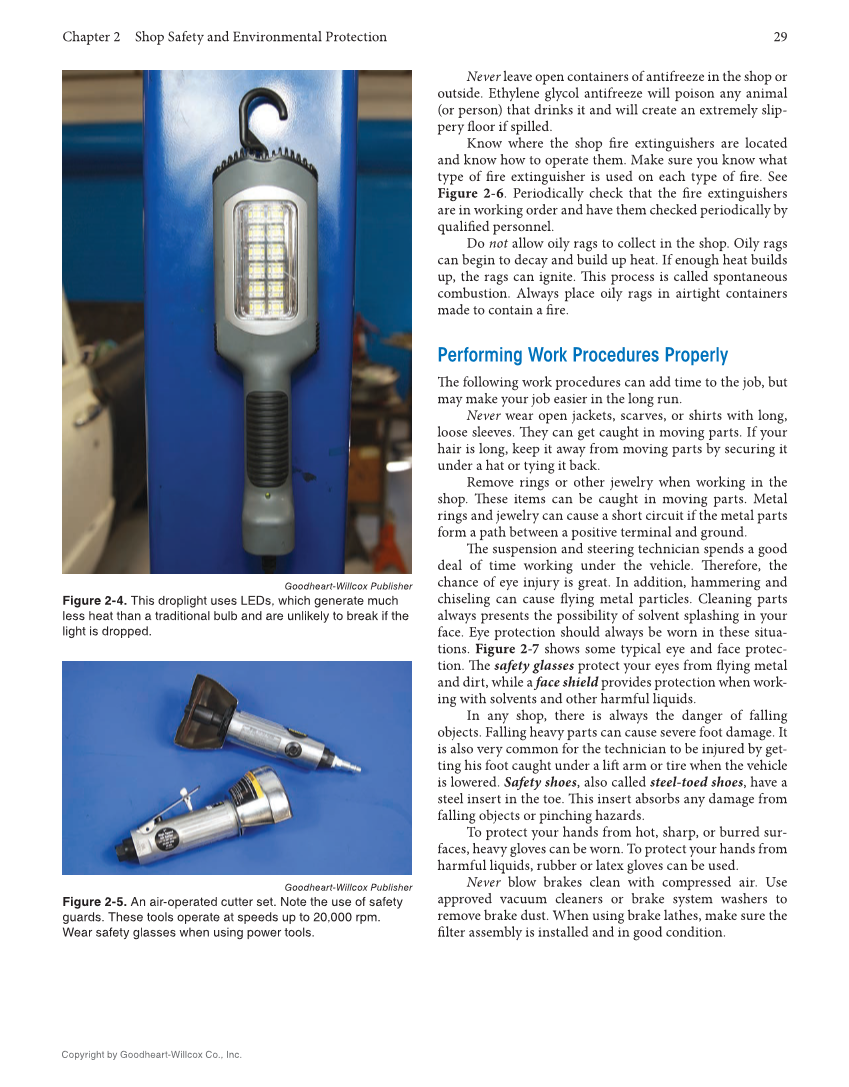Chapter 2 Shop Safety and Environmental Protection 29 Copyright by Goodheart-Willcox Co., Inc. Never leave open containers of antifreeze in the shop or outside. Ethylene glycol antifreeze will poison any animal (or person) that drinks it and will create an extremely slip- pery fl oor if spilled. Know where the shop fi re extinguishers are located and know how to operate them. Make sure you know what type of fi re extinguisher is used on each type of fi re. See Figure 2-6. Periodically check that the fi re extinguishers are in working order and have them checked periodically by qualifi ed personnel. Do not allow oily rags to collect in the shop. Oily rags can begin to decay and build up heat. If enough heat builds up, the rags can ignite. Th is process is called spontaneous combustion. Always place oily rags in airtight containers made to contain a fi re. Performing Work Procedures Properly Th e following work procedures can add time to the job, but may make your job easier in the long run. Never wear open jackets, scarves, or shirts with long, loose sleeves. Th ey can get caught in moving parts. If your hair is long, keep it away from moving parts by securing it under a hat or tying it back. Remove rings or other jewelry when working in the shop. Th ese items can be caught in moving parts. Metal rings and jewelry can cause a short circuit if the metal parts form a path between a positive terminal and ground. Th e suspension and steering technician spends a good deal of time working under the vehicle. Th erefore, the chance of eye injury is great. In addition, hammering and chiseling can cause fl ying metal particles. Cleaning parts always presents the possibility of solvent splashing in your face. Eye protection should always be worn in these situa- tions. Figure 2-7 shows some typical eye and face protec- tion. Th e safety glasses protect your eyes from fl ying metal and dirt, while a face shield provides protection when work- ing with solvents and other harmful liquids. In any shop, there is always the danger of falling objects. Falling heavy parts can cause severe foot damage. It is also very common for the technician to be injured by get- ting his foot caught under a lift arm or tire when the vehicle is lowered. Safety shoes, also called steel-toed shoes, have a steel insert in the toe. Th is insert absorbs any damage from falling objects or pinching hazards. To protect your hands from hot, sharp, or burred sur- faces, heavy gloves can be worn. To protect your hands from harmful liquids, rubber or latex gloves can be used. Never blow brakes clean with compressed air. Use approved vacuum cleaners or brake system washers to remove brake dust. When using brake lathes, make sure the fi lter assembly is installed and in good condition. Goodheart-Willcox Publisher Figure 2-4. This droplight uses LEDs, which generate much less heat than a traditional bulb and are unlikely to break if the light is dropped. Goodheart-Willcox Publisher Figure 2-5. An air-operated cutter set. Note the use of safety guards. These tools operate at speeds up to 20,000 rpm. Wear safety glasses when using power tools.
